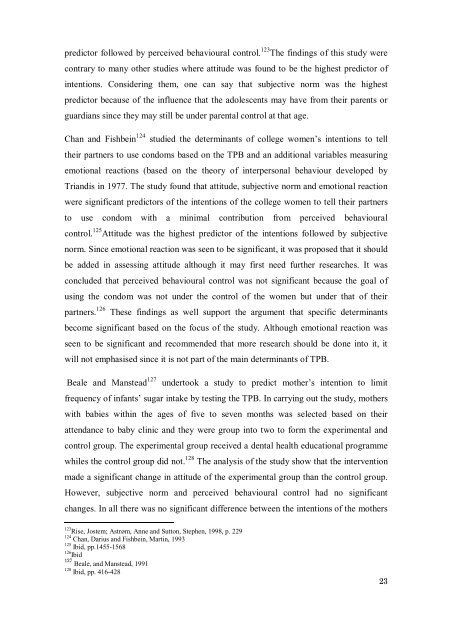A QUANTITATIVE APPROACH TO PREDICT ... - SuSanA
A QUANTITATIVE APPROACH TO PREDICT ... - SuSanA
A QUANTITATIVE APPROACH TO PREDICT ... - SuSanA
Create successful ePaper yourself
Turn your PDF publications into a flip-book with our unique Google optimized e-Paper software.
predictor followed by perceived behavioural control. 123 The findings of this study were<br />
contrary to many other studies where attitude was found to be the highest predictor of<br />
intentions. Considering them, one can say that subjective norm was the highest<br />
predictor because of the influence that the adolescents may have from their parents or<br />
guardians since they may still be under parental control at that age.<br />
Chan and Fishbein 124 studied the determinants of college women’s intentions to tell<br />
their partners to use condoms based on the TPB and an additional variables measuring<br />
emotional reactions (based on the theory of interpersonal behaviour developed by<br />
Triandis in 1977. The study found that attitude, subjective norm and emotional reaction<br />
were significant predictors of the intentions of the college women to tell their partners<br />
to use condom with a minimal contribution from perceived behavioural<br />
control. 125 Attitude was the highest predictor of the intentions followed by subjective<br />
norm. Since emotional reaction was seen to be significant, it was proposed that it should<br />
be added in assessing attitude although it may first need further researches. It was<br />
concluded that perceived behavioural control was not significant because the goal of<br />
using the condom was not under the control of the women but under that of their<br />
partners. 126 These findings as well support the argument that specific determinants<br />
become significant based on the focus of the study. Although emotional reaction was<br />
seen to be significant and recommended that more research should be done into it, it<br />
will not emphasised since it is not part of the main determinants of TPB.<br />
Beale and Manstead 127 undertook a study to predict mother’s intention to limit<br />
frequency of infants’ sugar intake by testing the TPB. In carrying out the study, mothers<br />
with babies within the ages of five to seven months was selected based on their<br />
attendance to baby clinic and they were group into two to form the experimental and<br />
control group. The experimental group received a dental health educational programme<br />
whiles the control group did not. 128 The analysis of the study show that the intervention<br />
made a significant change in attitude of the experimental group than the control group.<br />
However, subjective norm and perceived behavioural control had no significant<br />
changes. In all there was no significant difference between the intentions of the mothers<br />
123 Rise, Jostem; Astrøm, Anne and Sutton, Stephen, 1998, p. 229<br />
124 Chan, Darius and Fishbein, Martin, 1993<br />
125 Ibid, pp.1455-1568<br />
126 Ibid<br />
127 Beale, and Manstead, 1991<br />
128 Ibid, pp. 416-428<br />
23
















